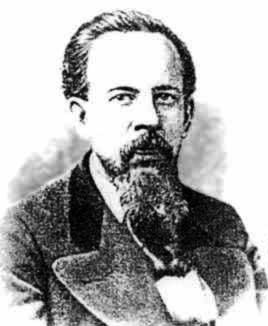


 تاريخ الرياضيات
تاريخ الرياضيات
 الرياضيات في الحضارات المختلفة
الرياضيات في الحضارات المختلفة 
 الرياضيات المتقطعة
الرياضيات المتقطعة
 الجبر
الجبر
 الهندسة
الهندسة 
 المعادلات التفاضلية و التكاملية
المعادلات التفاضلية و التكاملية 
 التحليل
التحليل
 علماء الرياضيات
علماء الرياضيات |
Read More
Date: 13-11-2016
Date: 13-11-2016
Date: 13-11-2016
|
Died: 19 April 1881 in Moscow, Russia

Karl Peterson's mother was Maria Mangelson and his father was Mikhail Peterson. Mikhail was a Latvian land worker from the lower class. Karl was born into a country which had been dominated by Russia since the end of the 18th century although Riga had been taken by the Russians long before. The Russian emperor Alexander I had granted freedom to the peasants a few years before Karl was born, but they did not grant serfs like Mikhail Peterson rights to buy land until the second half of the 19th century. This caused unrest in the Latvian lands throughout much of Peterson's life.
Karl attended the Gymnasium in Riga and he graduated in 1847 with excellent qualifications which meant that he as able to study at the University of Dorpat (now Tartu). Although a university had existed in Tartu since 1632, Peterson entered the Kaiserliche Universität zu Dorpat in Tartu (Dorpat) which had been established in 1802. At this University, Peterson studied under Ferdinand Minding. Minding had come to Dorpat in 1843 having followed a very unorthodox route to becoming a university professor. He did not study mathematics at university, but rather taught himself mathematics during his undergraduate years while taking courses in other topics. He then became a school teacher, undertaking research for a doctorate in his spare time. He was to have a strong influence on Peterson and give him the urge to undertake mathematical research. Peterson would follow in the footsteps of his professor in undertaking deep research while a school teacher, but unlike his professor he never became a university teacher.
Peterson wrote an unpublished "candidate's" thesis, Über die Biegung der Flächen (On the bending of surfaces) (Dorpat, 1853) on differential geometry. This dissertation was written in German but although it was retained in the archives of the University of Dorpat, it remained virtually unknown until it was published in Russian translation one hundred years later in 1952. The dissertation contains a derivation of two equations equivalent to those of Mainardi and Codazzi, and in it Peterson outlined a proof of the fundamental theorem of surface theory. The thesis also contains what has become known as Bonnet's theorem, published by Pierre Bonnet fifteen years later in 1867. In [8] Esther Phillips makes a strong case not only for Peterson's priority over Mainardi, Codazzi and Bonnet, but also for the greater elegance and simplicity of his approach.
After obtaining his candidate's degree, Peterson worked in Moscow as a teacher of mathematics. His first post was in a private school, then from 1865 he taught at the German Peter and Paul School.
His main work is in differential geometry but he obtained an honorary doctorate for his work on partial differential equations. This was in 1879 from the Novorossiiskii University of Odessa in recognition for his outstanding contributions to the theory of characteristics of partial differential equations [1]:-
... by means of a uniform general method, he deduced nearly all the devices known at that time for finding general solutions of different classes of equations.
Largely because he was not at a university his results were not well known but they did influence Egorov in Moscow, but Peterson gained an international reputation only when Darboux and Bianchi used his results. Belatedly he has gained the recognition he deserves; for example a class of surfaces is named after him. Another of the areas of his investigation was that of surfaces with nets. A conjugate system on a surface is a conical net, if it is formed by contact curves of circumscribed cones. Surfaces with such nets were first studied by Peterson in 1866.
In [6] this work is described as follows:-
Peterson's most important paper was 'On the ratios and relationships between curved surfaces' (1866), devoted to deformation of surfaces, which laid the foundation for a series of papers on the problem of bending on a principal basis, i.e., preserving the conjugacy of a certain net on the surface, the first example of which for deformation of surfaces of revolution on a surface of revolution was found by Minding ... (1838). Peterson's paper 'On curves on surfaces' (1867) and the book 'Über Curven und Flächen' (1868) were devoted to differential geometry. Some of the results of these papers of Peterson were later duplicated by G Darboux and other foreign geometers, but after E Cosserat's translations of Peterson's main works from 1866-1867 were published in Toulouse in 1905, his work achieved general recognition.
As mentioned in the quote, in 1905, nearly 25 years after his death, his papers were published in French translation by the University of Toulouse. These included: Sur l'intégration des équations aux dérivées partielles; Sur la déformation des surfaces du second ordre; Sur les courbes tracées sur les surfaces; and Sur les relations et les affinités entre les surfaces courbes.
In addition to his mathematical research while he taught in Moscow schools, Peterson also worked with Brashman and Davidov in founding the Moscow Mathematical Society. In fact the first such Society had been founded in 1810 but had ceased to function and a totally new Society, which Peterson helped found and organise, started to operate in 1864. Mathematicheskii Sbornik, the journal of the Society, first appeared in October 1866 and from that time on Peterson published almost all his research papers in that journal.
Books:
Articles:



|
|
|
|
علامات بسيطة في جسدك قد تنذر بمرض "قاتل"
|
|
|
|
|
|
|
أول صور ثلاثية الأبعاد للغدة الزعترية البشرية
|
|
|
|
|
|
|
العتبة الحسينية تطلق فعاليات المخيم القرآني الثالث في جامعة البصرة
|
|
|